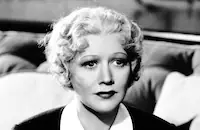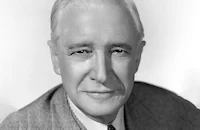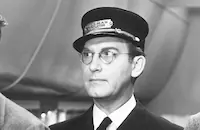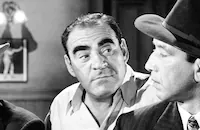The Lady from Cheyenne
Brief Synopsis
Cast & Crew
Frank Lloyd
Loretta Young
Robert Preston
Edward Arnold
Frank Craven
Gladys George
Film Details
Technical Specs

Synopsis
During a public land auction held in the township of Laraville, Wyoming by the Union Pacific Railroad, crooked land baron Jim Cork is told by his henchmen that he will have no problem buying the land he wants, as only settlers and speculators are present for the sale. As additional insurance, Steve Lewis, Cork's lawyer, is running the auction, and plans to suffer from selected deafness, accepting bids on the choice lots only from Jim's henchmen. Philadelphian Quaker schoolteacher Annie Morgan, however, spoils Cork's plans by buying one of the lots through an act of chivalry by Steve. After the auction, the town of Laraville quickly goes up, with Annie building a schoolhouse and Cork a saloon. When rival Turk tries to build another saloon, Cork frames him for murder. Steve then courts Annie in an attempt to persuade her to sell her land. The lawyer asks Annie to a square dance, and she innocently asks him to kiss her after a waltz. Steve's scheme is about to work until newspaper editor Hank Foreman tells the naïve Annie about Cork's water conspiracy, the success of which hinges on the purchase of Annie's land. After the land sale is canceled, Cork's men burn down Annie's schoolhouse and rough up Hank. Annie and the other settlers have a town meeting, and when the men refuse to stand up to Cork, Annie and the women decide to take matters into their own hands. When Cork is informed that the women plan to try him with a female jury, Steve proclaims that they cannot serve on a jury, as they are disenfranchised. Annie then goes to Cheyenne, the state capital, to introduce a bill on women's suffrage. She is accompanied on the train to Cheyenne by Steve, who has just been elected to the legislature. In the capital, Annie stays in a cheap hotel, where she meets prostitute Elsie. When Annie tries to address the state legislature, Steve helps pass a resolution barring women from the proceedings. Elsie then convinces Jerry Stover, one of her legislative "friends," to introduce Annie's bill. Steve has the bill referred to the judiciary committee, with himself as chairman. Later, legislative attendant George advises Annie to see the governor if she wants to get her bill out of Steve's committee, and steals an invitation to the governor's ball for her. Dressed in Elsie's and her chorus girl friends's best clothes, Annie charms the governor at the ball, but he tells her that he can be of little help, as she must "lobby" the legislature itself. With George's help, Annie plays the Democrats against the Republicans and tricks both parties into agreeing to vote for the bill. At the end of the ball, Steve confesses his love to Annie, but she rejects him, showing him a telegram stating that a settler named John Clark was killed by Cork. At the meeting of the legislature the next morning, Annie shows up with Elsie and her friendly "lobbyists." The bill is voted on by secret ballot and passes unanimously. Back in Laraville, Steve quits Cork's gang because of Clark's murder. Along with a contingent of reporters and special prosecutor Fitzpatrick, Annie heads by train back to Laraville. Before she arrives in town, however, Cork's gang stops the train and takes her into "protective custody." Steve and the townspeople ride to Annie's rescue, and Steve is wounded in the ensuing shootout. Cork is arrested and tried by the female jury, which finds him guilty of murder. Annie then rushes to the train station to stop Steve from leaving town and proclaims her love, offering to quit politics and marry him.

Director
Frank Lloyd
Cast

Loretta Young

Robert Preston

Edward Arnold

Frank Craven

Gladys George

Jessie Ralph
Stanley Fields

Willie Best

Samuel S. Hinds
Spencer Charters [dr.] Mr. Mcguinness
Clare Verdera
Alan Bridge
Charles Williams
Erville Alderson

Emmett Vogan
Roger Imhof

William Davidson

James Kirkwood
Wade Boteler

Ralph Dunn
Charles T. Aldrich

Harry Cording

Joseph Sawyer
Dorothy Granger

Marion Martin
Gladys Blake
Sally Payne

Iris Adrian
June Wilkins
Emory Parnell

Jeff Corey
Matt Mchugh
Larry Lawson
John Dilson
Joe Eggenton
Sue Moore

Charles Halton
Esther Howard
Phyllis Kennedy
Harry Seymour
Delmar Watson
Vic Potel
Bob Larson
Loren Raker
Harry Stubbs
Stanley Blystone
Roger Gray
Frank Austin
Kernan Cripps
Herbert Heywood
Dick Alexander
Kathryn Sheldon

Lloyd Ingraham
Murdock Macquarrie
Jessie Arnold

Griff Barnett
Charles Ray
Crew
Bernard B. Brown
Edward Curtiss
Warren Duff
Alanson Edwards
Jonathan Finn
Fred Frank
R. A. Gausman
John B. Goodman
Franklin Gray
William Hedgcock
Milton Krasner
Samuel Lerner
Frank Lloyd
Frank Lloyd
Theresa Oaks
Jack Otterson
Charles Previn
Charles Previn
Kathryn Scola
Frank Skinner
Jack H. Skirball
Vera West

Film Details
Technical Specs

Quotes
Trivia
Notes
The working title of this film was The Girl from Cheyenne. While the film's credits and reviews list the characters played by Clare Verdera and Alan Bridge as "Mrs. and Mr. Matthews," the characters are called "Clark" in the film. Universal press materials state that The Lady from Cheyenne was the first film that Frank Lloyd had produced at the studio in approximately twenty-five years. New York Times noted in February 1941 that this was to be the first film of a six-picture deal between Lloyd's Mayfair Productions and Universal. A July 1940 Hollywood Reporter news item states that, after the original story was purchased from writers Jonathan Finn and Theresa Oakes, Lloyd and his partner, Jack H. Skirball, entered into negotiations with actress Carole Lombard to star in the film. In November 1940, Mayfair began negotiations with actress Loretta Young, and on November 28, 1940, Hollywood Reporter confirmed that Young had been signed for the film, which initially was to begin production in late December 1940.
Three weeks after shooting began on January 2, 1941, the production moved to Mojave, CA, where a western town set had been especially constructed for the film. In early February 1941, journalists from twenty newspapers convened in Mojave to report on the location shooting, as part of Universal's publicity endeavors for the film. According to New York Times, since the Mojave location was within three hundred miles of Hollywood, the producers were forced to "bus in" Screen Actor's Guild extras each day, which cost the production an extra $3,600. A February 12, 1941 Hollywood Reporter news item states that actor Tom Chatterton was cast in the film, but his participation in has not been confirmed. Faith Brook, daughter of noted British actor Clive Brook, was reportedly "tested" for an unspecified role in the film in mid-February 1941, but her appearance in the final film also has not been confirmed. New York Times stated in January 1942 that, as a publicity stunt for the film's opening at the Senate Theater in Harrisburg, PA, theater ushers dressed as cowboys and rode horses up and down the aisles. Loretta Young starred with Robert Preston in a June 16, 1941 Lux Radio Theatre broadcast of the story.

Miscellaneous Notes
Released in United States 1941
Released in United States 1941











